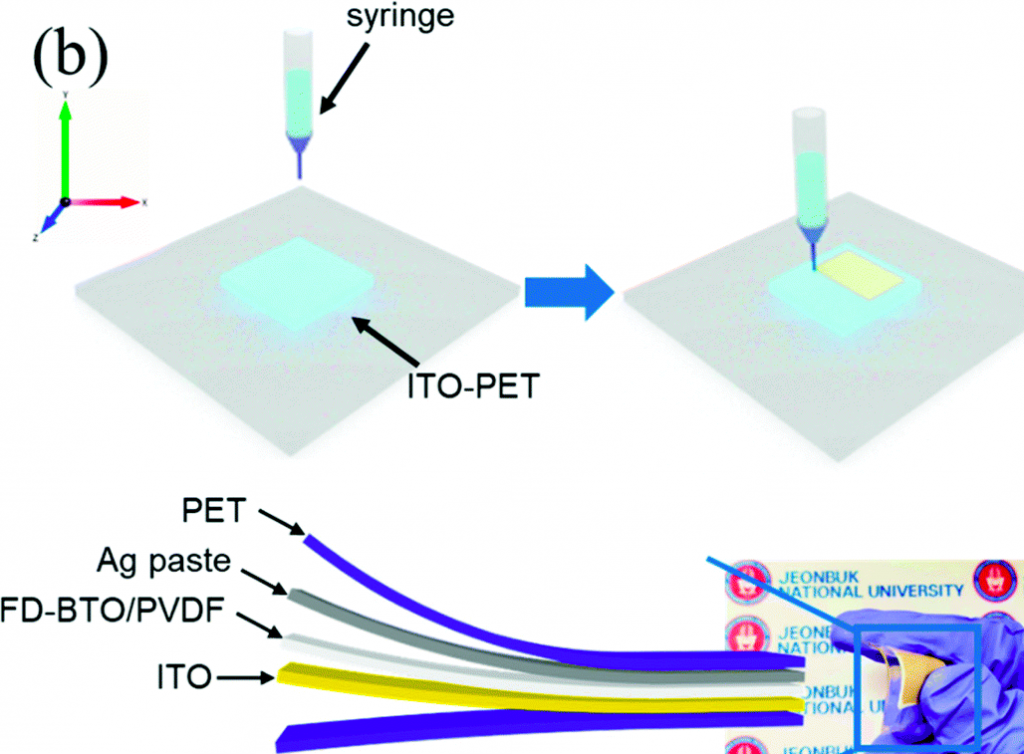Scientists from the Korean Jeonbuk National University and Chinese material provider Wuhan Chamtop have 3D printed novel wearable self-powered sensors.
Based on a unique barium-loaded PVDF polymer, the team’s fully-printed devices are effectively able to harvest the piezoelectric energy generated by human movement. When built into an array, the sensors proved capable of using this charge to detect pressure inputs and convert them into signals, a significant advance in the development of high-performance additive wearable electronics.

Piezoelectric-powered electronics
Given the potential of self-powered sensors in creating wearable medical or sports-related monitoring devices, it’s hardly surprising that they’ve become an increasingly hot topic of research. As opposed to normal battery-operated actuators, self-powered technologies are often more compact and eco-friendly, while being cheaper to make as well.
Piezoelectric devices hold particular promise in this area thanks to their flexibility, net power output and ease of fabrication, in addition to improved performance compared to triboelectric energy sources (e.g. static). While PVDF has emerged as a popular base material for 3D printing these sensors, it often needs to be filled with a nucleating additive, in order to achieve its optimal piezoelectric performance.
In previous studies, mixing the material with polymers has yielded devices with limited efficacy, while adding barium titanate (BTO) has been found to boost desirable properties, but caused particle aggregation. To combat this, the scientists have proposed 3D printing sensors using similar ingredients, albeit in a novel ‘mortise–tenon-shaped’ structure.

3D printing the sensor array
Once the researchers had identified the optimal PVDF-BTO formulation, they deployed a Musashi Engineering robotic arm-mounted 3D printer, to dispense the material into a film. A silver paste was then printed onto the device’s surface, before nickel tapes were used to mark its electrodes and it was subjected to poling under an electric field.
The resulting sensors were arranged into a U-shaped 7 × 7 cm2 array and subjected to characterization tests. Initial results revealed no noticeable BTO sedimentation in the resin, an important precursor to potential industrial applications. Interestingly, the team also found that increasing the level of BTO concentration in the films had a correlating impact on their piezoelectric properties.
For instance, those prototypes consisting of 10% barium nanoparticles (NPs) exhibited a current of 24.3 pC/N, while loading the samples with a concentration of 50%, increased this to 69.1 pC/N. Given their optimal performance, the latter sensors were later deployed within sporting evaluations, in which they were fitted to taekwondo protective gear.
When struck, the devices were able to detect the different levels of force applied based on the amount of voltage generated, something that could prove useful as an athlete training tool. Given the flexibility of their array, the scientists also propose that it could be 3D printed onto other wearables in future, enabling them to monitor various sporting activities without the need for external power sources.
Piezoelectric’s electrifying potential
3D printing with piezoelectric materials enables the production of battery-less devices with moving parts that could prove ideal for all sorts of clinical and soft robotic applications.
Scientists from the University of Wisconsin-Madison have utilized the technology to 3D print blood vessels capable of remotely monitoring a patient’s blood pressure. The tubular devices emit piezoelectric pulses, alerting patients to when they need to seek urgent medical attention, without the need for an external power source.
A consortium of Chinese researchers, meanwhile, have 3D printed a self-powered robotic finger that’s able to sense changes in curvature without using a conventional battery. The team hope that their multi-material additive digit will inspire the development of other piezo-powered soft robotics in future.
When it comes to novel materials, engineers from the Virginia Polytechnic Institute and State University have also made significant advances. In recent research conducted there, a team developed a piezoelectric ceramic for DLP 3D printing, and used it to create various complex self-sustaining structures.
The researchers’ findings are detailed in their paper titled “Mortise–tenon joint structured hydrophobic surface-functionalized barium titanate/polyvinylidene fluoride nanocomposites for printed self-powered wearable sensors.” The research was co-authored by Hai Li, Hoseong Song, Mengjie Long, Ghuzanfar Saeeda and Sooman Lim.
To stay up to date with the latest 3D printing news, don’t forget to subscribe to the 3D Printing Industry newsletter or follow us on Twitter or liking our page on Facebook.
Are you looking for a job in the additive manufacturing industry? Visit 3D Printing Jobs for a selection of roles in the industry.
Featured image shows a diagram of the team’s 3D printed sensor being tested in a taekwondo belt. Image via Nanoscale journal.



